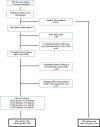Late-onset sepsis in very preterm infants in Norway in 2009-2018: a population-based study
- PMID: 36732047
- PMCID: PMC10447404
- DOI: 10.1136/archdischild-2022-324977
Late-onset sepsis in very preterm infants in Norway in 2009-2018: a population-based study
Abstract
Objective: To evaluate epidemiology and outcomes among very preterm infants (<32 weeks' gestation) with culture-positive and culture-negative late-onset sepsis (LOS).
Design: Cohort study using a nationwide, population-based registry.
Setting: 21 neonatal units in Norway.
Participants: All very preterm infants born 1 January 2009-31 December 2018 and admitted to a neonatal unit.
Main outcome measures: Incidences, pathogen distribution, LOS-attributable mortality and associated morbidity at discharge.
Results: Among 5296 very preterm infants, we identified 582 culture-positive LOS episodes in 493 infants (incidence 9.3%) and 282 culture-negative LOS episodes in 282 infants (incidence 5.3%). Extremely preterm infants (<28 weeks' gestation) had highest incidences of culture-positive (21.6%) and culture-negative (11.1%) LOS. The major causative pathogens were coagulase-negative staphylococci (49%), Staphylococcus aureus (15%), group B streptococci (10%) and Escherichia coli (8%). We observed increased odds of severe bronchopulmonary dysplasia (BPD) associated with both culture-positive (adjusted OR (aOR) 1.7; 95% CI 1.3 to 2.2) and culture-negative (aOR 1.6; 95% CI 1.3 to 2.6) LOS. Only culture-positive LOS was associated with increased odds of cystic periventricular leukomalacia (cPVL) (aOR 2.2; 95% CI 1.4 to 3.4) and severe retinopathy of prematurity (ROP) (aOR 1.8; 95% CI 1.2 to 2.8). Culture-positive LOS-attributable mortality was 6.3%, higher in Gram-negative (15.8%) compared with Gram-positive (4.1%) LOS, p=0.009. Among extremely preterm infants, survival rates increased from 75.2% in 2009-2013 to 81.0% in 2014-2018, p=0.005. In the same period culture-positive LOS rates increased from 17.1% to 25.6%, p<0.001.
Conclusions: LOS contributes to a significant burden of disease in very preterm infants and is associated with increased odds of severe BPD, cPVL and severe ROP.
Keywords: Intensive Care Units, Neonatal; Microbiology; Neonatology; Sepsis.
© Author(s) (or their employer(s)) 2023. Re-use permitted under CC BY-NC. No commercial re-use. See rights and permissions. Published by BMJ.
Conflict of interest statement
Competing interests: None declared.
Figures
References
MeSH terms
LinkOut - more resources
Full Text Sources
Medical

